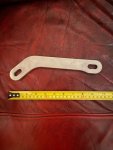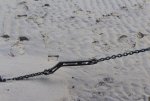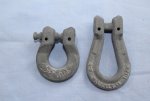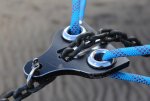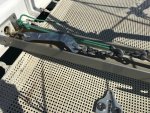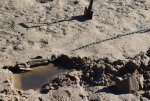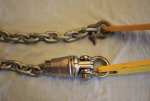Neeves
Well-Known Member
Norman,
Size does not matter its quality that counts.
But you raise an important issue. On some modern yachts designers have squeezed the location of the windlass so far forward (in order to increase the forepeak dimensions (even though you cannot use the extra space) that there is simply no space between the anchor shackle and windlass, when the anchor is housed. there I thus no room for a 'whatever'. Nothing new here - as Boathook confirms. If you are making your own 'whatever' you can vary the dimensions from those I quote and I have made a short boomerang - that works well. You still need links between boomerang and anchor and there is a proliferation of shackles - but a short boomerang works. You can also cut back on the links between boomerang and anchor, even 1 link will work.
Modern windlass are exceptionally quick. We find that if the anchor is going to arrive inverted then the Boomerang does what is intended and self rights the anchor. But this is quite a violent encounter and the anchor can still be widely gyrating when it actually hits the bow roller. We tend to stop the windlass when the boomerang hits the bow roller - everything then slows down, restart, the anchor self rights - but a bit more sedately.
My favourite steel maker, Bisalloy not only gave me a lump of plate (delivered on a pallet) but also some small bits and pieces from which I made ..... later or I'll introduce e some drift.
The long boomerang is as the dimensions in the article - the short one was restricted by the length of steel that Bisalloy gave me
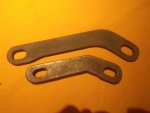
This illustrates a point I tried to make - as the anchor sets the shank end and toe bury together - you can see here the shackle has buried and the chain is about to be driven into the seabed (or it would do were we to drive it in - power set). But the Boomerang is sitting 'vertical' and if made and sized correctly has a cross section smaller than the chain - and actually enhances anchor performance. The Boomerang is the same as in the photo above. As background - we were drying out over night and not wanting to float away we had laid 3 anchors - one off the bow and one, with dyneema rodes, of each transom.

This is one of Her Majesty's vessels and they, being experts in the field, have no need to frequent Forum nor read learned yachting journals and have not learnt the means to self right an anchor (and it would be a waste of time to try to point out the error of their ways).
This is the result:

Just check next time you see one of 'our' new aircraft carriers - if the anchor is housed correctly then maybe tucked away unseen is a monster Boomerang - maybe proving - it is never too late to learn.

However I would not want to discourage anyone from making their own Boomerang, nor even discourage anyone from making a 'whatever'. I hope I have illustrated there is room for personalisation and they could make great conversation pieces.
Jonathan
Size does not matter its quality that counts.
But you raise an important issue. On some modern yachts designers have squeezed the location of the windlass so far forward (in order to increase the forepeak dimensions (even though you cannot use the extra space) that there is simply no space between the anchor shackle and windlass, when the anchor is housed. there I thus no room for a 'whatever'. Nothing new here - as Boathook confirms. If you are making your own 'whatever' you can vary the dimensions from those I quote and I have made a short boomerang - that works well. You still need links between boomerang and anchor and there is a proliferation of shackles - but a short boomerang works. You can also cut back on the links between boomerang and anchor, even 1 link will work.
Modern windlass are exceptionally quick. We find that if the anchor is going to arrive inverted then the Boomerang does what is intended and self rights the anchor. But this is quite a violent encounter and the anchor can still be widely gyrating when it actually hits the bow roller. We tend to stop the windlass when the boomerang hits the bow roller - everything then slows down, restart, the anchor self rights - but a bit more sedately.
My favourite steel maker, Bisalloy not only gave me a lump of plate (delivered on a pallet) but also some small bits and pieces from which I made ..... later or I'll introduce e some drift.
The long boomerang is as the dimensions in the article - the short one was restricted by the length of steel that Bisalloy gave me

This illustrates a point I tried to make - as the anchor sets the shank end and toe bury together - you can see here the shackle has buried and the chain is about to be driven into the seabed (or it would do were we to drive it in - power set). But the Boomerang is sitting 'vertical' and if made and sized correctly has a cross section smaller than the chain - and actually enhances anchor performance. The Boomerang is the same as in the photo above. As background - we were drying out over night and not wanting to float away we had laid 3 anchors - one off the bow and one, with dyneema rodes, of each transom.

This is one of Her Majesty's vessels and they, being experts in the field, have no need to frequent Forum nor read learned yachting journals and have not learnt the means to self right an anchor (and it would be a waste of time to try to point out the error of their ways).
This is the result:

Just check next time you see one of 'our' new aircraft carriers - if the anchor is housed correctly then maybe tucked away unseen is a monster Boomerang - maybe proving - it is never too late to learn.
However I would not want to discourage anyone from making their own Boomerang, nor even discourage anyone from making a 'whatever'. I hope I have illustrated there is room for personalisation and they could make great conversation pieces.
Jonathan

